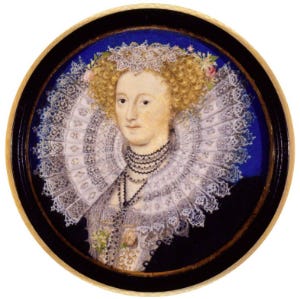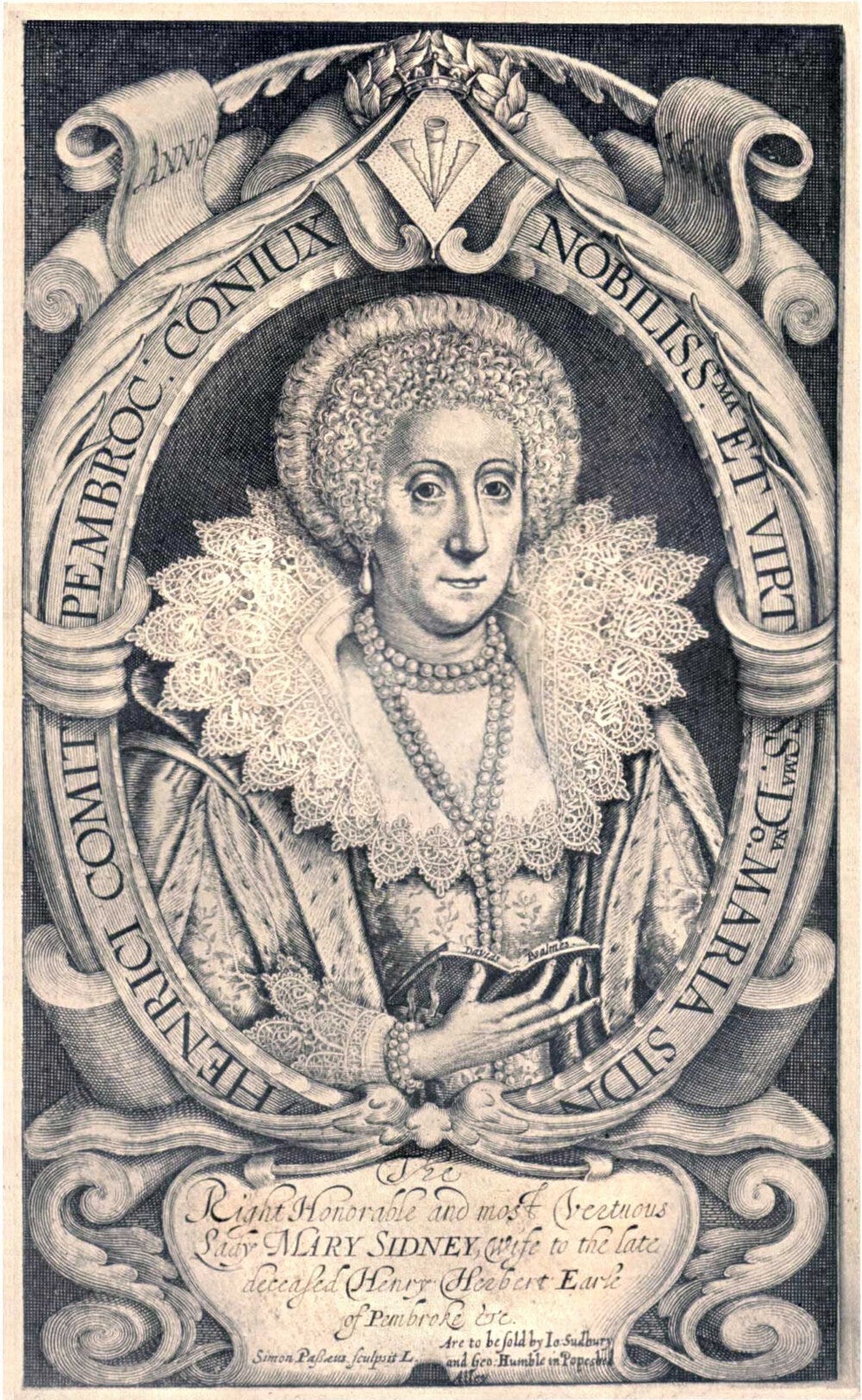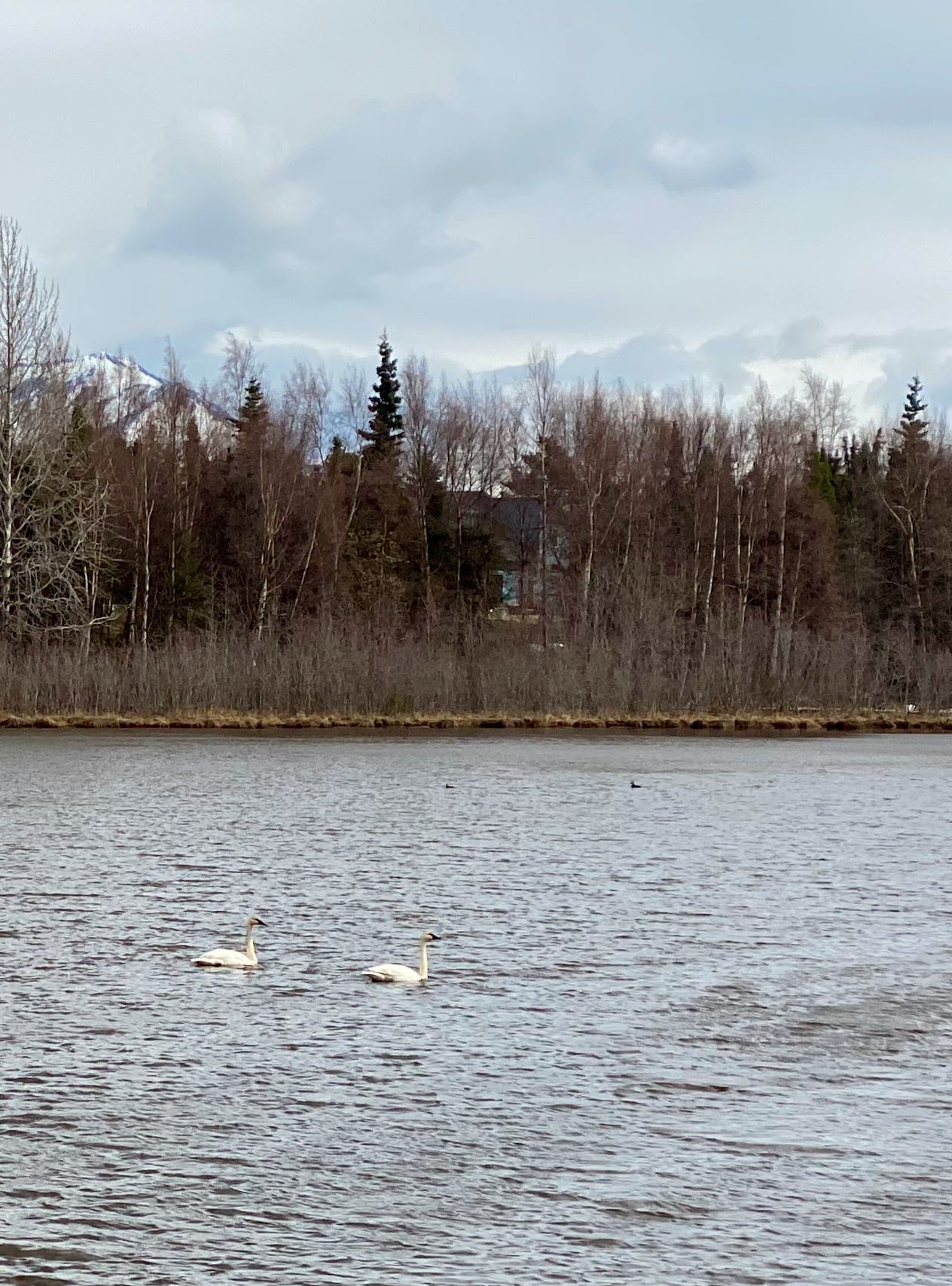A pair of swans returned to the pond near our house yesterday—they always look more striking when the water is inky black, the sky becoming darker with rain rather than snow. I thought I had heard their low baritone bell-beat the other afternoon, but wasn’t positive. When I saw them I knew it had been them, and felt reassured. There is still very much a lack of color in this northern landscape, but signs like the swans’ presence are such welcome reminders that spring will return soon.
I wrote once about the swans leaving in the fall—their moonlight bodies bright against the ambering of the birches beyond the shores. It was windy then, and it is blowing again today—I wonder if they bring it with them, riding its swells like waves above our heads.
In Greek myth, the swan is a bird of heaven, its migration a link that joins the peoples of the Mediterranean to the Hyperboreans—a mythical utopian land at the north of the back wind, beyond the horizon. As birds of Apollo, they circled the island of his birth seven times, and then bore him to their home “on the shores of the ocean beyond the North Wind, where the Hyperboreans lived under a sky which was always clear.”1 Swans thus also symbolize the power of poetry, an emblem of the divinely-inspired poet.
I began writing poetry when I was assigned it unexpectedly in a literature class—and that class transformed my relationship with writing. I fell in love with language, with Gerard Manley Hopkins. I learned the thrill of the sound of words and language in poetry, in the power they could instill. Of the new meanings that crack open with experimentation in line length, break, breath. I’ve been in love with poetry ever since.
But the writing of it comes in bursts, an ebb and flow that’s hard to predict. A migratory reach that seems to appear and then return south again.
Swan feathers were often the preferred writing instrument before modern pens. The most durable and smooth, and of course harder to come by. Curing a quill took months of drying, forming, and trimming before it would be strong enough to serve the task of writing. And in that act of their wing feathers becoming a pen, how apt that these birds of Apollo, symbols of poetry, helped countless poets to write—becoming the literal device of poetry.
A woman who was fond of swan feather quills and had them framing her portrait ascending from mirrored ink wells was Mary Sidney (1561–1621)—an Elizabethan writer who in her time was thought to be one of the most skilled poets of the age, attested to by her patrons, students, and admirers, like Ben Jonson, John Donne, and Samuel Daniel. And yet so few know of her works today.

Sidney was a polymath—she owned an alchemy lab and worked with Walter Raleigh’s brother as her assistant. Her recipe for invisible ink still exists. She spoke multiple languages, including most likely Hebrew which was less common at the time and a part of why her nuanced translations of religious texts hold some of the intended incantation that the original Hebrew holds. She played and composed music, creating a secret code where each measure represented a letter. And was a skilled embroiderer.
But perhaps most importantly, she held a famous literary circle, where she and her brother, Philip Sidney, would share manuscripts and ideas with other writers of the day—many of which likened their salon to a University. Samuel Daniel, a friend and student, wrote a dedication to Sidney’s son, William Herbert, noting her influence:
Having been first encouraged and framed thereunto by your most worthy and honorable mother, and received the first notion for the formal ordering of those compositions at Wilton, which I must ever acknowledge to have been my best school and thereof always am to hold a feeling and grateful memory.2
But the only publicly acceptable work for a woman writer was for religious texts, such as translation—something that would occupy a woman’s time, while she still stayed within the lines of submitting to the authority of an earlier, male-written text. Anything else—particularly anything verging on the personal—could ruin a woman’s reputation and lead to her downfall publicly and socially. It was a fine needle to thread. As a result, what did make it to print more widely in Sidney’s own time were her translations of the Psalms into verse.
Sidney was able to publish a few other translations—of Petrarch, a French discourse on death, as well as a closet drama—i.e., a play to be performed at home, not in public. This was the play Antonie, the first drama to be published under a woman’s own name. The play deftly employs history to comment on contemporary politics, and it went through several printings in 1592, 1595, 1600, 1606, and 1607. Sidney was also one of the first dramatists to write her work in blank verse.3
What Mary Sidney accomplished with the translations of the Psalms, however, is a monument to poetic form, voice, and learning. She took up the project after her brother had died in battle after translating the first 43, only to re-work those that he had finished, and complete the rest. Not only did she translate 164 psalms, she used 163 different stanzaic forms, as well as 94 different metrical patterns.4
It’s an astounding work of scholarship. One scholar writes of this work that: “Indeed, there is no collection of lyrics in English which uses such a wide range of meter.”5 Sidney’s psalter became a model of poetic and rhetorical principles in English, with dual attention paid to both form and meaning, converting the Psalms into more personal episodes of struggle, faith, grief, and sorrow—using them as a type of mask to explore a variety of voices that a woman could not otherwise express in public. As R.E. Pritchard writes:6
If Countess [Mary Sidney], as Elizabethan lady, could not easily speak out publicly, she could at least, as mouthpiece for the Psalmist’s (male) voices, and like some of Shakespeare’s heroines, speak most for herself when speaking for another.
Sidney became one of the most well-known writers of the day, and her patronage of other writers and theater groups helped to create many plays, such as Samuel Daniel’s Cleopatra in 1611, written at her request. His dedication to her reflects the adoration that so many held for her work:
Behold the work which once thou didst impose, Great sister of the Muses' glorious star, Of female worth, who didst at first disclose Unto our times, what noble powers there are In women's hearts, and sent example far To call up others to like studious thoughts.
Mary Sidney’s sons were connected at court, and came to oversee the printing register—which authorized all works printed at the time. The first folio of Shakespeare is dedicated to these sons, those “incomparable brethren.”
And that’s one of many overlaps and interests in why scholars are turning more toward Mary Sidney as a possible author of the plays of Shakespeare. Given the restrictions on a woman’s name in print, it is plausible that many of the early modern works we know today may have been written by women—and many of the first published works of Shakespeare did not have a name tied to them until later. As Virginia Woolf wrote famously in A Room of One’s Own, “anonymous was a woman.”
But setting that intrigue aside, Mary Sidney is credited in the Oxford English Dictionary (OED) with over forty words, many of which also appear in the plays—words like sea-monster, unpeopled—as well as over 140 she used for the first time in English—such as measure, shallow, embowel, disaster, disposer, chamberer, imprison, infant, lease, self, waitress, unseat, and winged. Robin P. Williams, who wrote a book of research tying these threads of Sidney’s together, also writes that there are words that the OED cites as first being used by Shakespeare, but were in fact used first by Sidney—e.g., lonely, which appears in Corialnus in 1607, but was used in Sidney’s play Antonie first published in 1592. Williams writes:
She invented words such as feathery, heart-broken, head-long, re-become, empearl, powerfulness, surrounded, mix as a noun, wondered as used in The Tempest, soundless deep as used in Sonnet 80.7
Regardless of circumstantial evidence, the idea that the world knows the words of this woman without knowing her name, seems like something that would be worthwhile for many quills to rectify.
And that’s what made me think of Sidney as I watched the swans this afternoon—because the symbol of the Sidney family was the swan—most likely with its close sound to the French cygne, but also no doubt as both she and her brother were esteemed poets. Mary Sidney chose to be known by her maiden name. In her later portrait, she wore lace with swans embroidered into the pattern of a ruff, with swan wings at the bottom of the frame, flanked by swan quills and ink wells on either side, topped with a laurel wreath as she holds her book of psalms. This was a woman who wanted to be—and was—known as a poet.

Another aspect of the swan in myth is its role as holding both the light of the sun (male) and the light of the moon (female). As the symbol incorporating both these lights, the swan has often been thought to represent a hermaphrodite:
If [the swan] remains undivided and, as is sometimes the case, tries to bear the synthesis of both, the swan becomes hermaphroditic and even more highly charged with mystery and holiness.8
I wonder if Mary Sidney felt some of that, having to take on the persona of a male voice—whether in the Psalms, the translations of men’s works, or if she did indeed write the works of Shakespeare—in order to have her own song heard. And if she became more highly charged with mystery because of that elusive inability to publish as a woman.
As I walked the pond in the company of the swans gliding slowly through the cool, recently frozen water, I thought about all of this myth and symbol sparked by their arrival—the line between north and south connected by their bodies, visible lands and invisible, known and mythical. Of their representation in myth as bearing Apollo, the god of poetry, to the lands beyond the horizon and back. And how fitting it is that Mary Sidney chose to identify with these birds, whose wings gave her a way to create her own flight through time on the page.
So many connections between the lands of the Hyperboreans and our own, if we only find ways to notice it.
Chevalier, Jean and Alain Gheerbrant. 1996. The Penguin Dictionary of Symbols. Trans. by John Buchanan-Brown. Penguin Books. p. 954
Williams, Robin P. 2019. Sweet Swan of Avon: Did a Woman Write Shakespeare? Third edition. Wilton Circle Press. p. 75
Ibid. p. 80
Ibid. p. 89
Cerasano, S.P. and Marion Wynne-Davies, eds. 1998. Readings in Renaissance Women's Drama Criticism, History, and Performance 1594-1998. Routledge. p. 15
Pritchard, R.E. ed. 1992. Mary Sidney (and Sir Phillip Sidney): The Sidney Psalms. Carcanet Fyfield Books. p. 18
Williams, Robin P. 2019. Sweet Swan of Avon: Did a Woman Write Shakespeare? Third edition. Wilton Circle Press. p. 173
Chevalier, Jean and Alain Gheerbrant. 1996. The Penguin Dictionary of Symbols. Trans. by John Buchanan-Brown. Penguin Books. p. 952












Freya, our very own Great Sister of the Muses, this reads like the mission statement of the Ariadne Archives.
Behold the work which once thou didst impose,
Great sister of the Muses' glorious star,
Of female worth, who didst at first disclose
Unto our times, what noble powers there are
In women's hearts, and sent example far
To call up others to like studious thoughts.
I am glad you fell in love with language - I am in love with your use of it! It feels like feathers on skin, the loveliest brushing. And this: “ Anything else—particularly anything verging on the personal—could ruin a woman’s reputation and lead to her downfall publicly and socially. It was a fine needle to thread.” I am glad you are rectifying the anonymity. So much has been buried, and I still feel this threat in my cells. Your excavations give me courage to keep digging, bringing feminine voices to the light ❤️🔥